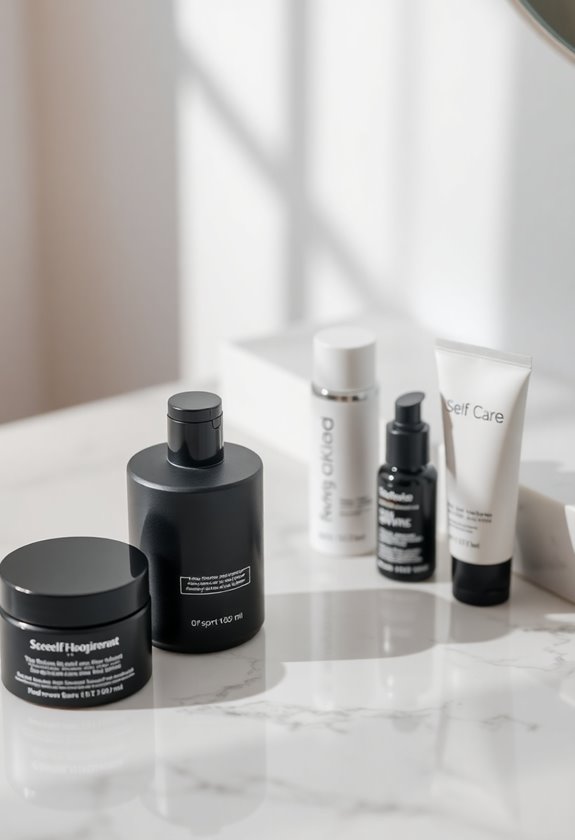To repair damaged hair in 2025, you’ll need an all-encompassing routine that combines proven treatments with innovative care methods. Start with a sulfate-free shampoo and follow up with a deep conditioning treatment once weekly, focusing on even product distribution through sectioned hair. Apply a leave-in conditioner and heat protectant before any styling, and incorporate bond-building treatments to repair broken protein structures. Natural remedies like coconut oil and avocado masks can supplement your routine between professional salon treatments, while maintaining a consistent nighttime hair care ritual. Understanding the full spectrum of recovery techniques will transform your hair’s health from root to tip.
Highlights
- Begin with a sulfate-free shampoo and deep conditioning treatment weekly, focusing on even product distribution through sectioned hair.
- Apply a bond-building treatment like Olaplex to repair broken protein bonds, followed by a lightweight leave-in conditioner.
- Protect hair from heat damage using a high-quality protectant spray rated for at least 450°F before styling.
- Incorporate natural treatments like coconut oil and avocado masks weekly to nourish and repair split ends.
- Maintain regular professional salon treatments, including keratin therapy and ultrasonic steam conditioning for maximum nutrient absorption.
Understanding Hair Damage Types
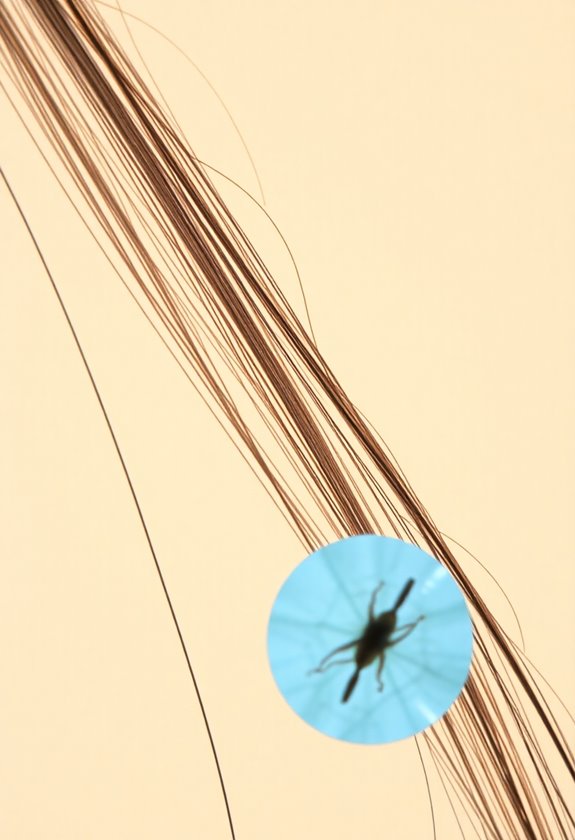
Before diving into hair recovery, you’ll need to identify what type of damage you’re dealing with. Your hair can experience several distinct forms of damage that require different treatment approaches.
Common types of hair damage include:
- Chemical damage from coloring, perming, or relaxing treatments that break down your hair’s protein structure
- Heat damage from styling tools that weaken and dehydrate your hair shaft
- Environmental damage from sun exposure, chlorine, and salt water that strip natural oils
- Physical damage from tight hairstyles, rough brushing, or excessive manipulation
- Nutritional damage from poor diet or medical conditions that affect hair growth
Once you’ve identified your specific type of damage, you’ll be better equipped to choose the right recovery treatments and products that target your hair’s unique needs.
Essential Hair Recovery Products
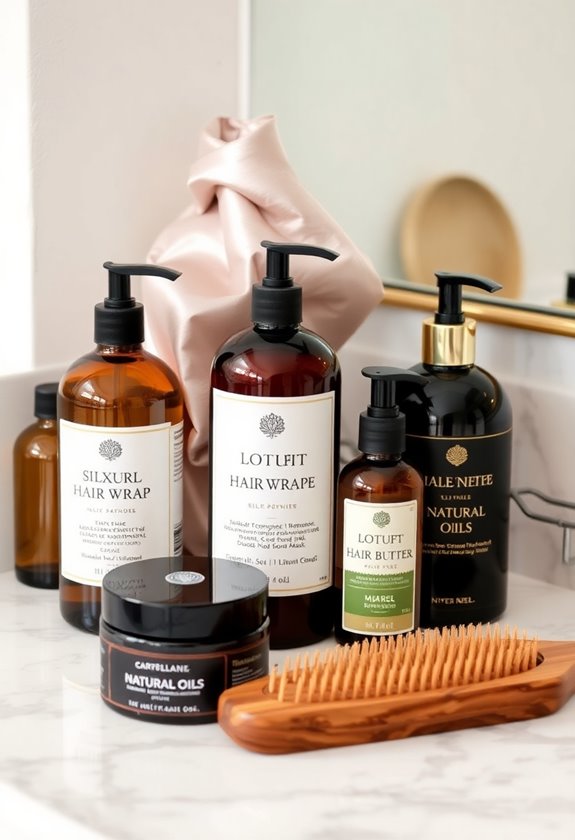
So what products should you stock up on for your hair recovery journey? You’ll need several essential items to restore your damaged strands to their former glory:
- Deep conditioning treatment with keratin or protein to rebuild hair structure
- Moisturizing leave-in conditioner that won’t weigh hair down
- Heat protectant spray or serum (minimum 450°F protection)
- Bond-building treatment to repair broken hair bonds
- Sulfate-free shampoo specifically formulated for damaged hair
- Microfiber towel to prevent friction damage
- Wide-tooth comb or detangling brush designed for wet hair
When selecting these products, you’ll want to look for ingredients like ceramides, panthenol, and hydrolyzed proteins that can penetrate the hair shaft while providing both immediate and long-term repair benefits for your damaged strands. Finding the right hair care products depends on understanding your specific hair type and damage level.
Weekly Deep Conditioning Treatment
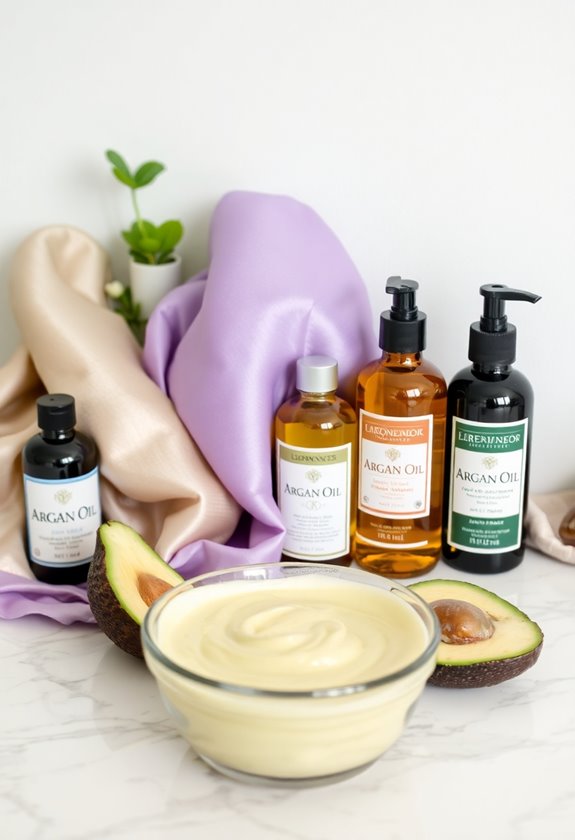
Making time for a deep conditioning treatment once per week is essential for repairing damaged hair. You’ll want to apply your chosen deep conditioner to freshly washed, towel-dried hair, focusing on the mid-lengths and ends where damage is most prevalent.
Here’s how to maximize your treatment:
- Section your hair into 4-6 parts for even product distribution
- Apply the conditioner using downward strokes to prevent tangling
- Cover your hair with a shower cap to trap heat and enhance penetration
- Let the treatment sit for 20-30 minutes, or follow product instructions
- Rinse thoroughly with cool water to seal the hair cuticle
For severely damaged hair, you can enhance the treatment’s effectiveness by using a heated cap or sitting under a hooded dryer during the processing time.
Natural Remedies for Hair Repair
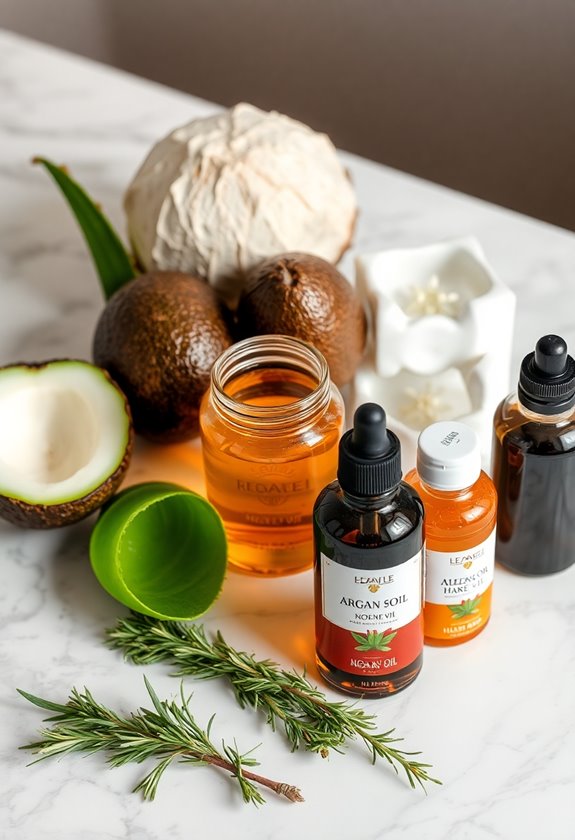
Several natural ingredients found in your kitchen can effectively repair damaged hair without harsh chemicals. You’ll find that ingredients like coconut oil, avocado, and raw honey work wonders to restore your hair’s natural shine and strength.
Here’s how to use these powerful natural remedies:
- Mix two tablespoons of coconut oil with one mashed avocado for a nourishing hair mask that’ll deeply penetrate your hair shaft and repair split ends
- Apply raw honey mixed with equal parts olive oil to damp hair, focusing on damaged areas while gently massaging it into your scalp
- Create an egg white and yogurt treatment by combining one egg white with three tablespoons of plain yogurt, which helps rebuild protein bonds in your hair structure
Remember to leave these treatments on for 20-30 minutes before rinsing thoroughly with lukewarm water.
Heat Protection and Styling Tips
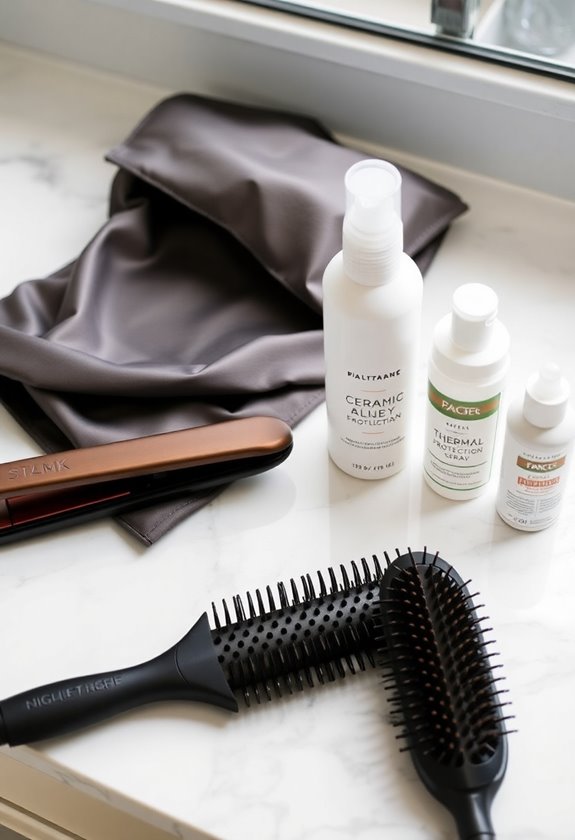
While natural remedies can repair existing damage, protecting your hair from future harm is equally important. You’ll need to establish a heat-protection routine that shields your strands from styling tools and environmental stressors.
- Always apply a heat protectant spray or serum before using any hot tools, ensuring complete coverage from roots to ends.
- Keep your flat iron and curling wand temperature below 365°F (185°C), as higher temperatures can break down your hair’s protective keratin layer.
- Don’t style wet hair with heat tools, as this can cause the water inside your strands to boil and create bubbles that weaken the hair shaft.
- Use heat styling tools no more than 2-3 times per week, and consider air-drying your hair whenever possible.
Diet and Supplements
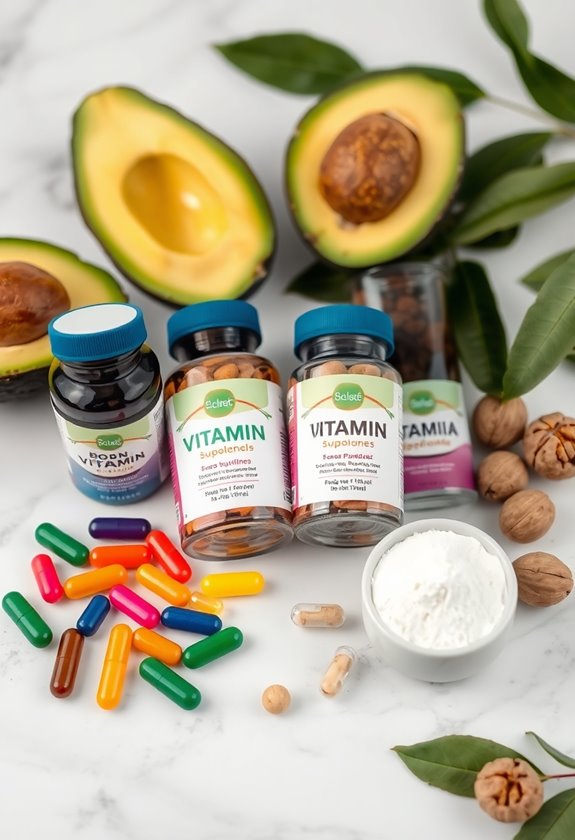
Your body’s nutritional intake plays an essential role in hair health and recovery. You’ll need key nutrients like biotin, omega-3 fatty acids, iron, and vitamins A, C, and E to support hair growth and repair.
Consider incorporating these essential elements into your daily routine:
- Take a high-quality biotin supplement (2,500-5,000 mcg daily)
- Add fatty fish or fish oil supplements for omega-3s
- Include iron-rich foods like spinach, lentils, and lean meats
- Consume vitamin C through citrus fruits to enhance iron absorption
For the best results, you’ll want to pair these nutrients with adequate protein intake, aiming for 0.8 grams per kilogram of body weight daily. If you’re experiencing significant hair damage, consult with a healthcare provider before starting any new supplement regimen.
Professional Salon Treatments

Professional treatments at high-end salons offer specialized solutions for severely damaged hair that can’t be fully addressed with at-home care. You’ll find transformative options like deep conditioning treatments, keratin therapy, and bond-rebuilding services that penetrate deep into your hair’s structure.
Consider these essential salon treatments for peak hair recovery:
- Olaplex treatments that rebuild broken protein bonds within your hair shaft
- Brazilian keratin therapy for intense protein replenishment and frizz control
- Deep conditioning with ultrasonic steam therapy for maximum nutrient absorption
- Split-end removal treatments using specialized hot scissors
- Custom protein-moisture balancing treatments tailored to your hair type
Schedule these treatments every 6-8 weeks for best results, and you’ll notice significant improvements in your hair’s strength, shine, and manageability.
Nighttime Hair Care Routine
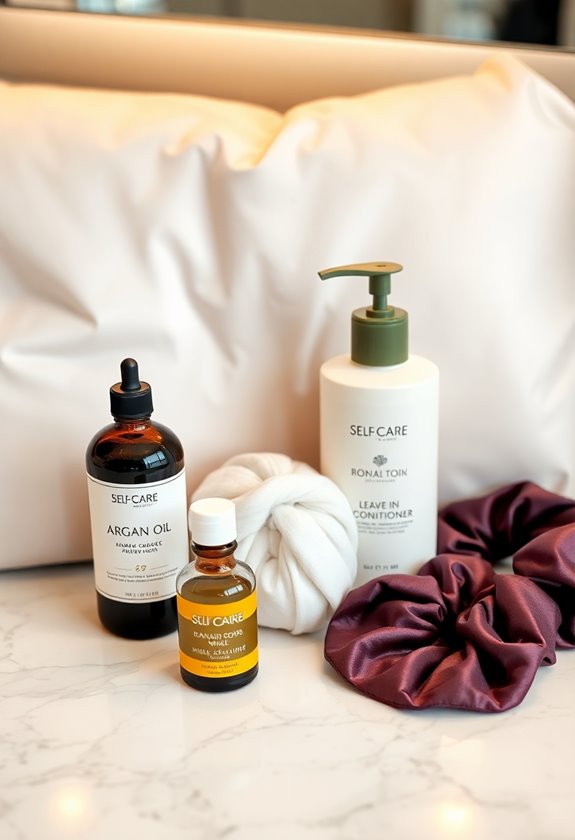
Developing a consistent nighttime hair care routine is essential for repairing damaged hair while you sleep. You’ll need to start by gently detangling your hair with a wide-tooth comb and applying a leave-in conditioner or hair oil to seal in moisture throughout the night.
- Switch to a silk or satin pillowcase to reduce friction and prevent breakage
- Loosely braid your hair or wrap it in a silk scarf to minimize tangling
- Apply a protein-rich hair mask twice weekly before bed
- Keep hair elevated on the pillow to prevent oil buildup at the roots
For extremely damaged hair, you’ll want to deep condition overnight once a week, making sure to protect your pillow with a towel while the treatment works its restorative magic.
Hair Recovery Success Stories
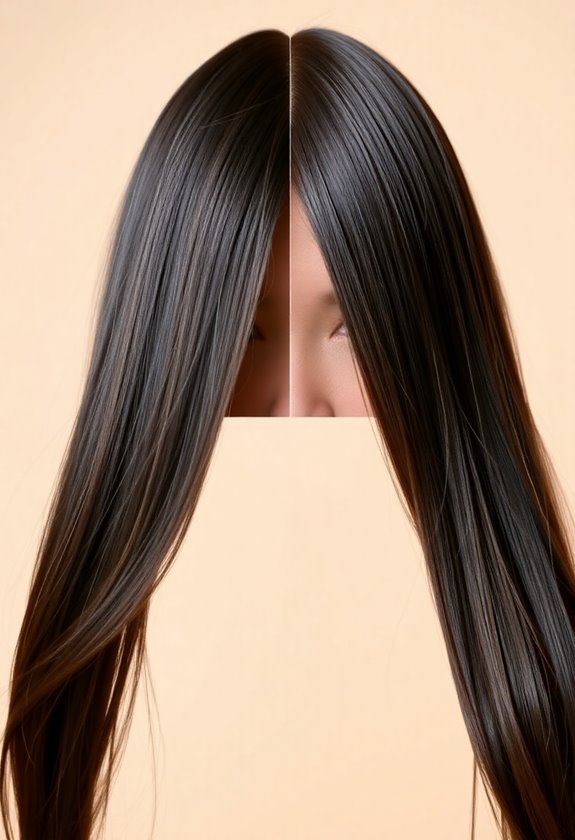
While nighttime routines can work wonders, real-life success stories demonstrate just how effective proper hair care practices can be. You’ll find inspiration in stories like Sarah’s, who transformed her bleach-damaged hair through a six-month recovery plan focusing on protein treatments and moisture balance.
Consider Michelle’s journey, where she restored her heat-damaged curls by implementing a strict protective styling routine and deep conditioning twice weekly. Another remarkable transformation comes from James, who reversed years of chemical damage by switching to natural products and maintaining a consistent pre-wash oil treatment schedule. These success stories share common elements that you can apply to your own recovery journey:
- Consistent routine adherence
- Natural product changes
- Regular deep conditioning
- Patience with the process
- Professional guidance when needed
Frequently Asked Questions
How Long Does It Typically Take to See Results From a Recovery Routine?
You’ll typically notice initial improvements in your hair’s manageability and shine within 2-3 weeks of consistent treatment. More significant results, like reduced breakage and improved strength, become apparent after 6-8 weeks of dedicated care. For severe damage, you’ll need to maintain your recovery routine for 3-6 months before seeing complete transformation, as hair growth and repair cycles require sustained attention.
Can Pregnancy Hormones Affect the Success of Hair Recovery Treatments?
Pregnancy hormones can considerably affect your hair recovery treatments, as they influence how your hair grows, sheds, and responds to products. During pregnancy, you’ll notice increased hair thickness due to elevated estrogen levels, but postpartum hormone changes may temporarily increase shedding. It’s best to adjust your recovery routine during pregnancy and consult your healthcare provider about which treatments are safe to continue using.
Is It Possible to Reverse Gray Hair While Following Recovery Routines?
While you’re working on your hair recovery journey, you can’t technically reverse existing gray hair through standard hair care routines. Your hair’s color comes from melanin-producing cells that naturally decrease with age. However, you can support your hair’s overall health through proper nutrition, particularly with foods rich in catalase, vitamin B12, and copper, which may help slow down the graying process in new hair growth.
Should I Trim My Hair During the Recovery Process if Split Ends Appear?
Yes, you should absolutely trim your hair when split ends appear during the recovery process. Split ends can travel up the hair shaft and cause more damage if left untreated. You’ll want to schedule regular trims every 8-12 weeks to maintain healthy hair, as this prevents further breakage and allows your recovery routine to work more effectively on the healthier portions of your strands.
Can Chlorine From Swimming Pools Interfere With Hair Recovery Treatments?
You’re swimming in dangerous waters when it comes to chlorine and hair recovery. Chlorine will strip your hair of its natural oils and can greatly interfere with treatment products you’re using. The chemical bonds with your hair proteins, causing dryness, brittleness, and color changes that’ll set back your recovery progress. You’ll need to protect your hair by wearing a swim cap and applying a leave-in conditioner before swimming to create a protective barrier.




